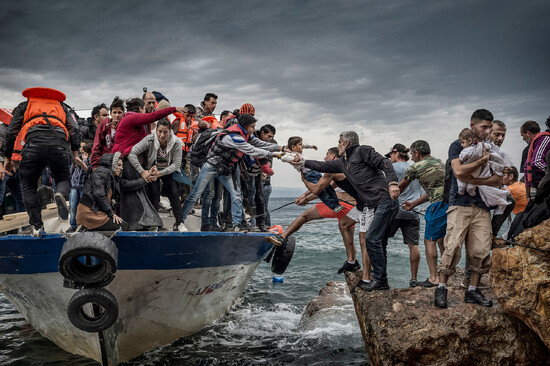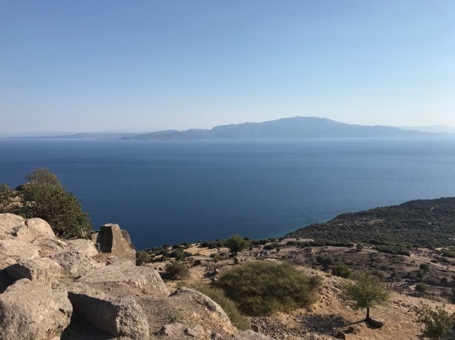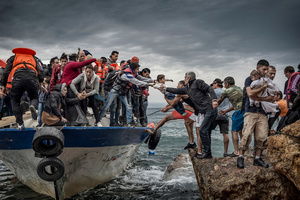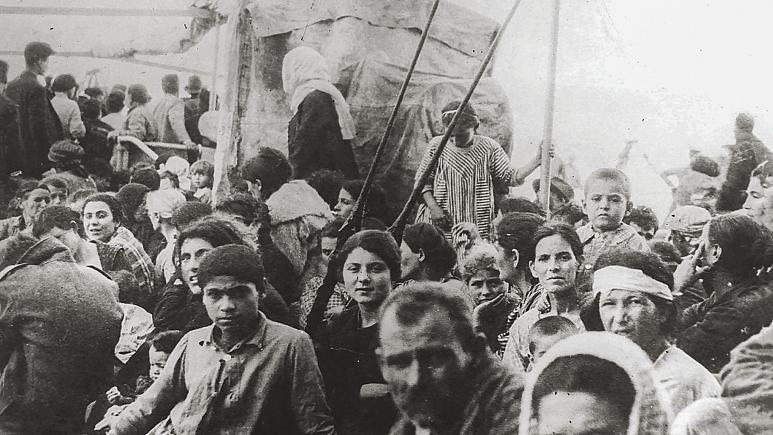East, West and In-Between: Past and Present Imaginings

The Aegean Sea is full of contrasts. At the edges of Europe and Asia, its sparkling blue waters blur not only the imagined fault lines of an East-West divide, but also those between past and present.
The pristine nature of Aegean shorelines, mountaintops and historic ruins acts as an annual magnet for millions of tourists in search of peace, tranquillity and simplicity. For these visitors, majestic panoramas of an endlessly expansive horizon offer a seeming portal to paradise.
However, many have travelled to Aegean shores not in search of respite, but rather as a last resort. From the perspective of forced migrants attempting to survive the perilous journey across its at-once mythical and tantalising horizon, this paradoxical landscape evokes a quite different set of emotions. Inclusive of their stories, the Aegean Sea is thus also imbued with a complex history of misery, anguish, bravery and resilience.
We must remind ourselves then, that while some dive into Aegean waters headfirst, many others are forced to take the plunge. Moreover, rather than simply being a portal to paradise, for many the Aegean Sea is also a portal to purgatory.


Less than 10 kilometres from the Turkish mainland, the Aegean island of Lesbos – the third largest of the Greek islands - is full of its own contrasts. Lesbos was once best known for its idyllic beaches, celebrated status as the birthplace of the Ancient Greek poetess Sappho, and for its production of both olives and ouzo.
Throughout 2015, migrants fleeing the Syrian Civil War and other global conflicts received a warm welcome on Lesbos, where many local islanders threw open their homes to new arrivals. In recognition of their efforts, the residents of Lesbos, along with those of a few other Greek islands, were collectively nominated for the Nobel Peace Prize in 2016.
The island’s initially humane and compassionate response to fears of a European migrant crisis was indeed striking, all the more so considering the degree to which tensions and hostilities between forced migrants and local islanders on Lesbos have now escalated, reaching previously unimaginable heights.
Today, rather than remaining a haven for forced migrants, Lesbos has instead become a symbol of Europe’s ever-toughening stance towards migration. For those who survived the journey across the Aegean Sea from Turkey, the island has transformed into an open-air prison. Forced migrants continue, often for years at a time, to languish in squalid, overcrowded and under-resourced camps across the island.

Source: LensCulture, Accessed June 2021.
To make matters worse, many of these camps have been packed well beyond their intended capacities. Until September 2020, when a fire burned the camp to the ground and rendered most of its former residents homeless, over 13,000 migrants resided in the island’s notorious Moria Camp. However, when it had first been constructed in 2013, the camp had an intended capacity of only around 1,000 residents, and after its expansion in 2015, of only around 3,000 residents.
For the former residents of Moria and other forced migrants on Lesbos, time has all but stopped. An ever-expanding atmosphere of fear and hate has left them imprisoned in a geographic limbo between Asia and Europe, a bureaucratic limbo between displacement and asylum, and an emotional limbo between traumatic pasts and uncertain futures, giving considerable rise to both acute and chronic mental health crises.
Nevertheless, the appalling conditions of migrants on Lesbos is not a stand-alone case, but rather symptomatic of a much broader picture. Between 2015 and 2016, over one million forced migrants fleeing war and persecution, primarily from across the Middle East, Asia and Africa, set afoot on uncertain and precarious journeys towards Europe.
Many did not survive. Others were stranded in unexpected destinations along the way, and among those who did reach the European mainland, many were simply turned back upon arrival. Even those who succeeded in filing asylum claims often faced new threats to their survival, trapped in severely neglected camps, mismanaged detention centres, or simply on the streets as they awaited the outcomes of lengthy, dysfunctional and inefficient asylum procedures.
During this time, harrowing, yet now iconic, images of migrants on overcrowded boats in the Mediterranean and Aegean Seas, marching on foot along the Balkan route to Europe or rendered lifeless along the way sent shockwaves around the world. Although not a new phenomenon, this was the first time that the experience of forced migration, along with its overwhelming emotional impact on individuals, had been documented in such an up-close and comprehensive manner.
The unprecedented nature of these images sparked divergent, yet equally intense, public reactions. On the one hand, the images triggered a massive outpouring of compassion and support for forced migrants, and also outrage on the part of human rights activists demanding that European governments uphold their dignity and human rights.
On the other hand, many feared a rise in forced migrants entering Europe as a threat to European culture, democracy and security, often conflating this fear with those of an imagined Muslim ‘Other’ supposedly incompatible with European norms and values. In large part, this reaction has been a reflection of rising populist sentiment across Europe in recent decades, among communities, politicians and governments alike.
Today, the initial media frenzy of the so-called European migrant crisis has all but expired. Among the general public, the suffering and death of migrants, along with their Othering as a social, economic and security threat, has been largely normalised. Harsh and abusive migration policies, rather than sparking protests and demonstrations among those in support of migrants, are now no longer challenged on a widespread scale. Rather, they have been justified as necessary evils aimed at protecting Europe.
In effect, those very same images of forced migration that once sent shockwaves around the world have now become commonplace, banal and largely ignored. Not only is the world increasingly desensitized, but also increasingly distracted. Throughout recent years, media headlines have successfully redirected public attention towards other global issues such as racial justice, climate change and the COVID-19 pandemic.
Nevertheless, the issue of forced migration has not faded away along with its media attention. On the contrary, along with other global crises such as those listed above, it continues to require fervent attention and action on the parts of governments, civil society actors and civilians alike.
This remains especially evident in Greece, Turkey and across the Aegean landscape. It was here that between 2015 and 2016, hundreds of thousands of mostly Syrian forced migrants entered Europe via Greek-Turkish borders. It is also here that many forced migrants remain in limbo in Greece, or, since the signing of the EU-Turkey deal in 2016, in Turkey.
Moreover, it was along these borders that another humanitarian crisis unfolded in early 2020 when Turkish president Recep Tayyip Erdogan announced the opening Turkey’s borders with Europe in political retaliation for the death of 34 Turkish soldiers in Syria. This announcement prompted a near immediate flood of manipulated migrants to the Greek-Turkish border, where they were not only rejected entry into Greece, but also violently pushed back to Turkey or imprisoned by the Greek authorities, as well as trapped for months on end in unsafe conditions.
Yet along Greek-Turkish borders, as well as in other regions across the globe, the acknowledgement that the issue of forced migration has persisted since 2015 is only part of the story. It must also be acknowledged that issues related to forced migration and other contemporary socio-political circumstances rarely exist in isolation, but more often than not, are deeply rooted in the distant past. Just as the case of Lesbos is part of a wider picture of recent migration trends in Europe, so is the perception of a European migrant crisis part of a wider picture of centuries-old controversies over how to define European identity.
As a starting point for understanding this, we can travel back in time to nearly 100 years ago, when strikingly similar events were unfolding in these very same Aegean waters between Greece and Turkey. In the aftermath of WWI, the signing of the 1923 Treaty of Lausanne ended the hostilities of the 1919-1922 Greco-Turkish War, formalised the establishment of a modern Turkish state out of the ashes of a crumbling Ottoman Empire, and also marked a new era in the realms of both Greek and Turkish foreign policy.
However, the Treaty of Lausanne also came at a significant human cost. One of its most momentous impacts on individuals came in the form of a compulsory Greco-Turkish population exchange which resulted in the permanent expulsion of millions of Greek Orthodox inhabitants of Eastern Thrace and Asia Minor to Greece and hundreds of thousands of Muslim inhabitants of Greece to Turkey. This marked the first time in history in which a compulsory population exchange took place under international law with religion as its sole criterion.
Despite high levels of linguistic and cultural diversity among both Greek and Turkish communities at the time, all followers of the Greek Orthodox faith were labelled ethnic Greeks and all followers of Islam were labelled ethnic Turks. The blurred reality of these boundaries, however, meant that due to persisting linguistic and cultural barriers, many faced hostility and disorientation both upon arrival in their new supposed homelands and for decades following.
Although images of the 1923 Greco-Turkish population exchange failed to capture global media headlines in the same manner as did those of the perceived European migrant crisis between 2015 and 2016, images of the two occurrences are undoubtedly reminiscent of one another:


Source: EuroNews, September 2020.
These two cases not only illustrate the consequences of rising nationalism, populism, religious sectarianism, and the rhetoric of securitization, but also illuminate the true tragedy of nation-building projects: the valuing of state interests over human lives. Indeed, lost homes, loved ones and livelihoods are recurring patterns in contexts of displacement across the globe.
An undeniable link also exists between the rhetoric surrounding the 1923 Greco-Turkish population exchange and contemporary fears of Islam in Europe. In essence, the 1923 Greco-Turkish population exchange was an experiment in ethnic engineering aimed at synonymising Greek-Turkish borders with those of an imagined East-West, or Europe-Islam, divide. In doing so, the architects of the Treaty of Lausanne sought not only to homogenise both the Greek and Turkish populations, but also attempted to institutionalise claims of who belongs where: Christians in Europe and Muslims anywhere outside.
This rhetoric against Islam lives on in Europe today, and in tandem with the construction of migrants and minorities as cultural, economic and security threats, it continues to contribute to the spread of fears about Muslim migrants as threats to both European livelihoods and Europe itself. This fear can be seen in the policies of some European governments to not only resist the settlement of Muslim migrants in Europe since 2015, but also to launch programs aimed at the settlement of solely Christian migrants.
These ties between current anti-Muslim sentiment and the 1923 Greco-Turkish population exchange serve as a reminder that the desire to exclude Muslims in Europe is far from a newly emerged sentiment, nor is it simply a product of a post-9-11 global reality as commonly misperceived. Rather, anti-Muslim sentiment in Europe is driven by centuries-old ideas that throughout history have been intertwined with nascent conceptualisations of East and West, Europe and Asia, Christendom and Islamdom.
Fundamentally, this all comes down to a single myth: that of the clash of civilisations. This myth is ultimately about belonging and boundary-keeping along the fault lines of an imagined East-West divide, and throughout history it has often manifested as a perceived clash between Europe and Islam. Through its lens, we see how seemingly disconnected occurrences of conflict and displacement at the contact zone between Europe and Asia are actually linked to one another.
As has also begun to occur with the so-called European migrant crisis, the 1923 Greco-Turkish population exchange has now been largely forgotten. Nevertheless, it continues to shape the economic, political, social, cultural and even linguistic realities of Greece and Turkey, just as recent patterns of, and responses to, migration in the region will undoubtedly do for decades to come. As we near the 100th anniversary of the Treaty of Lausanne, there are thus still multiple lessons to be drawn from its impact.
One of the most crucial can be put quite simply: rather than merely consisting of a conglomeration of lost moments in time, the past remains very much alive in the present. History is not only crucial to understanding our present, but it can also help us understand our future; in the face of new opportunities, we would thus do well to not continue to squander its lessons. For those in doubt, one must look no further than the Aegean Sea.
is a researcher of migration, nationalism, memory, identity and belonging in Southeast Europe and Central Asia. She holds a B.A. in International Comparative Studies from Duke University, and an M.A. in International Migration from the University of Kent.